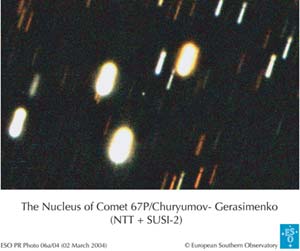ESO’s Telescope Takes Picture of ESA’s Rosetta’s Target, Comet 67P/Churyumov-Gerasimenko

In the morning of March 2, the Rosetta spacecraft was launched on board an Ariane-5 launcher from the European Spaceport in Kourou, French Guiana. The European Space Agency (ESA) spacecraft will be the first to land on a comet.
Before the launch, and as a salute to their colleagues at ESA, astronomers used the New Technology Telescope at the European Southern Observatory (ESO) of La Silla in Chile to image Rosetta’s target, Comet 67P/Churyumov-Gerasimenko, an approximately 4 kilometre size “dirty snowball” that orbits the Sun once every 6.6 years.
These new images show the object at a distance of approximately 670 million kilometres from the Sun – 4.5 times the distance from the Earth to the Sun.
These observations provide further confirmation that at this distance the activity on 67P/Churyumov-Gerasimenko is very low.
This is very good news for the mission, because it means that when Rosetta will meet in 2014 its target comet, at 790 million kilometres from the Sun, there will not be so much dust near the nucleus to hinder the landing.
Originally timed to begin about a year ago, Rosetta’s journey had to be postponed. This delay meant that the original mission’s target, Comet Wirtanen, which was observed two years ago by astronomers using ESO’s Very Large Telescope (see ESO PR Photo 06/02) could no longer be reached. Instead, a new target has been selected, Comet Churyumov-Gerasimenko.
The observations presented here are part of a continuous effort by astronomers to monitor Rosetta’s target and provide the spacecraft controllers and the astronomers with very useful, regular updates, e.g., about the ’cometary weather’ at the time of arrival.
Media Contact
More Information:
http://www.eso.org/outreach/press-rel/pr-2004/phot-06-04.htmlAll latest news from the category: Physics and Astronomy
This area deals with the fundamental laws and building blocks of nature and how they interact, the properties and the behavior of matter, and research into space and time and their structures.
innovations-report provides in-depth reports and articles on subjects such as astrophysics, laser technologies, nuclear, quantum, particle and solid-state physics, nanotechnologies, planetary research and findings (Mars, Venus) and developments related to the Hubble Telescope.
Newest articles

Machine learning algorithm reveals long-theorized glass phase in crystal
Scientists have found evidence of an elusive, glassy phase of matter that emerges when a crystal’s perfect internal pattern is disrupted. X-ray technology and machine learning converge to shed light…

Mapping plant functional diversity from space
HKU ecologists revolutionize ecosystem monitoring with novel field-satellite integration. An international team of researchers, led by Professor Jin WU from the School of Biological Sciences at The University of Hong…

Inverters with constant full load capability
…enable an increase in the performance of electric drives. Overheating components significantly limit the performance of drivetrains in electric vehicles. Inverters in particular are subject to a high thermal load,…





















